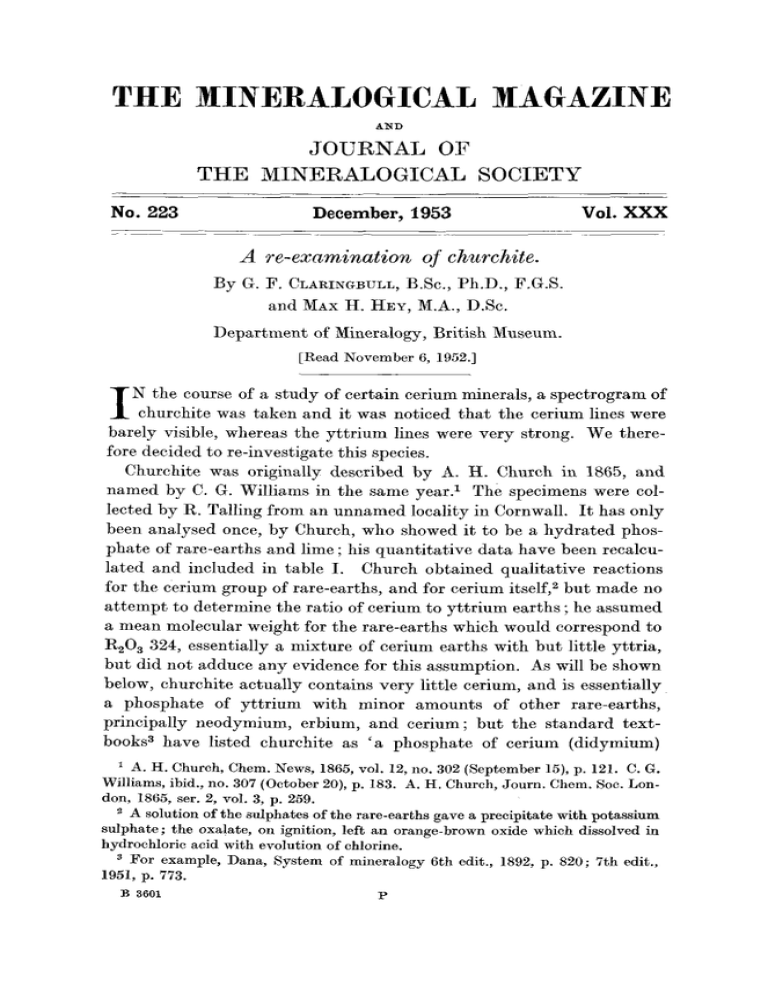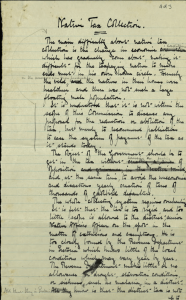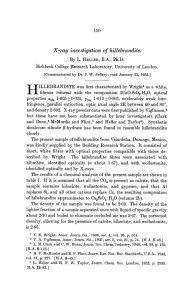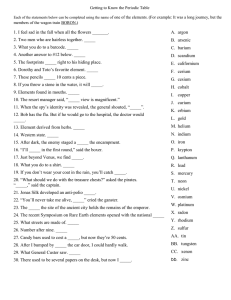the mineralogical magazine
advertisement

THE MINERALOGICAL MAGAZINE
A1ND
JOURNAL OF
T H E MINERALOGICAL SOCIETY
No. 223
December, 1953
Vol. XXX
A re-examination of churchite.
By G. F. CLARINGBULL, B.Sc., Ph.D., F.G.S.
and MAX H. HEY, M.A., D.Sc.
Department of Mineralogy, British Museum.
[Read November 6, 1952.]
N the course of a study of certain cerium minerals, a spectrogram of
churchite was taken and it was noticed t h a t the cerium lines were
barely visible, whereas the y t t r i u m lines were very strong. We therefore decided to re-investigate this species.
Churchite was originally described b y A. H. Church in 1865, and
named b y C. G. Williams in the same year. 1 The specimens were collected b y R. Talling from an unnamed locality in Cornwall. I t has only
been analysed once, b y Church, who showed it to be a h y d r a t e d phosphate of rare-earths and lime ; his quantitative d a t a have been recalculated and included in table I. Church obtained qualitative reactions
for the cerium group of rare-earths, and for cerium itself, 2 but made no
a t t e m p t to determine the ratio of cerium to y t t r i u m earths ; he assumed
a mean molecular weight for the rare-earths which would correspond to
R20 a 324, essentially a mixture of cerium earths with b u t little yttria,
but did not adduce any evidence for this assumption. As will be shown
below, churchite actually contains very little cerium, and is essentially
a phosphate of y t t r i u m with minor amounts of other rare-earths,
principally neodymium, erbium, and cerium; b u t the standard textbooks 3 have listed churchite as ' a phosphate of cerium (didynfium)
I
A. H. Church, Chem. News, 1865, vol. 12, no. 302 (September 15), p. 121. C.G.
Williams, ibid., no. 307 (October 20), p. 183. A. H. Church, Journ. Chem. Soc. London, 1865, set. 2, voL 3, p. 259.
2 A solution of the sulphates of the rare-earths gave a precipitate with potassium
sulphate ; the oxa!ate, on ignition, left an orange-brown oxide which dissolved in
hydrochloric acid with evolution of chlorine.
z For example, Dana, System of mineralogy 6th edit., 1892, p. 820; 7th edit.,
1951, p. 773.
B 3601
:p
212
G. F. C L A R I N G B U L L A N D M. H. B E Y ON
and calcium', overlooking the fact t h a t Church only claimed it as a
phosphate of the cerium earths and only gave qualitative evidence of
the presence of cerium, to which C. G. Williams added qualitative evidence of the presence of neodymium or praseodymium or both.
I n 1922, H. L a u b m a n nI described a phosphate of y t t r i u m from the
lqitzelbuch mine, Auerbach, Bavaria, under the name weinsehenkite,
a name which unfortunately was used almost simultaneously b y G.
Murgoci 2 for a variety of hornblende ; an analysis by F. Henrich showed
that the mean molecular weight of the rare-earths was R~O3 251"8, and
the formula for the mineral YtP04.2tt20 , with some Er and probably
Tb replacing Yr. I n 1935 a new analysis (table I) and re-determination
of the mean molecular weight of the rare-earths by F. Henrich a gave
ReO a 248.1 ; the relative abundances of the rare-earths were determined
by optical and X-ray spectrography. I n 1942 H. Strunz 4 gave unit-cell
dimensions for weinschenkite (from Auerbach) and noted its structural
similarity to gypsum.
The only other known occurrence of a rare-earth phosphate of this
type is at Kelly Bank mine, Vesuvius, Roekbridge County, Virginia.
From here C. Milton, K. J. Murata, and M. M. Knechtel5 describe
material agreeing in optical data and X-ray powder photograph with
Bavarian weinschenkite; it was not analysed, b u t a spectrographic
study showed it to be an y t t r i u m phosphate essentially similar to the
Bavarian except for a rather higher proportion of Y b ; its specific
gravity is 3"263 and the mean molecular weight of the rare-earths,
257-0, is practically the same as that for the Bavarian and, as will be
seen below, the Cornish material. From a study of the paragenesis,
1 F. I-Ienrich,Ber. Deutsch. Chem. Gesell., 1922, vol. 55, Abt. B, p. 3013 (October 14). [M.A. 2-12.] It. Laubm~nn, Geognost. Jahreshefte, .Geol. Landesunters.
Miinchen, 1923, vol. 35 (for 1922), p. 193. [M.A. 2 522.] A preliminary note by F.
Henrich appeared in Edel-Erden und -Erze, 1921, vol. 2, p. 181, but the present
authors have not been ~ble to see this paper, and it is not clear whether the name
weinschenkite appears in it or not.
G. Murgoci, Compt. Rend. Aead. Sci. Paris, 1922, vol. 175, p. 372 (August 21)
and p. 426 (September 4). [M.A. 2~21.]
a F. Henrich, Jouru. Prakt. Chem., 1935, vol. 142, p. 1.
4 H. Strunz, Naturwiss., 1942, vol. 30, p. 64. [M.A.8-368.] We adopt the setting
with fi 113~ 2u given in Dana (7th edit., vol. 2, p. 772) for the structure cell, and not
the setting with fl 129~24' adopted by Strunz. The transformation matrix from
Strunz's to our setting is ILl01/010/00111. This setting corresponds to that adopted
by Dana (loc. cir.) for gypsum, brushite, and pharmacolite.
5 C. Milton, K. J. Murata, and M. M. Knechtel, Amer. Min., 1944, vol. 29, p. 92.
[M.A. 9-54.]
~ E - E X A M I N A T I O N OF C H U R C H I T E
213
Milton, M u r a t a , a n d K n e c h t e l conclude t h a t t h e Virginian m i n e r a l
p r o b a b l y owes its origin t o a b i o c h e m i c a l c o n c e n t r a t i o n o f y t t r i u m in
c h e s t n u t a n d h i c k o r y leaves.
A n e w a n a l y s i s (table I) m a d e o n 105 rag. of Cornish c h u r c h i t e f r o m
t h e B r i t i s h M u s e u m s p e c i m e n (B.M. 40636), p u r c h a s e d f r o m R. Talling
TABLE I. Chemical analyses and unit-ceil contents of churchite.
1.
2.
(Yt, Er)20a ... 41"37 /
(La, Nd)~O3... 7-99~ 54.6
C%Oa
... 1.05J
Fe20 a
... 1-43
-CaO . . . . . .
1-55
5'4
P205
... 31"10 28.4
ttaO . . . . . .
15"29 1 4 - 9
insol . . . .
--99-78 103.3
D~~ . . . . . .
3.265 3-14
3.
4.
5 2 - 4 7 52.90
0-24
---3 0 . 2 0 31-15
1 6 . 4 2 15.96
0'38
0-23
99.71 100"24
---
la.
3a.
4a.
Yt
... 2.95"~
Er
... 0.28
(La,Nd) 0.45j 3.92
3"89
Ce
... 0"06]
Fe
... 0-17
0"03
-Ca
... 0"26
--POt ... 4.08
4
4
H~O ... 7-91
8'57
8-08
~(§
12.24 11.85 11.67
E(--)... 12-24 12-0
12-0
1. Churchite, Cornwall (B.M. 40636). Mean mol. wt. of yttria fraction 239-4,
corresponding approx, with Yt~O3, 35'7, Er20 a 5.7 ~o.
2. Churchite, Cornwall. Anal. A. H. Church, 1865. Re-calculated from Church's
weights on the assumption that his ceric oxide was essentially a trioxide,
mainly of yttria, and using modern atomic weights.
3. Weinschenkite, Bavaria. F. Heurich, 1922. Mean tool. wt. of'total rare-earths
251.8; corresponding approx, with Yt~O3 41-3, Er203 11.2 ~o4. Weinschenkite, Bavaria. F. Henrich, 1935. Mean tool. wt. of total rare-earths
248.1.
la. Empirical unit-cell contents calculated from the analysis and density of col. 1,
together with the unit-cell dimensions determined on the same specimen.
3a. t Atomic ratios, calculated from the analyses of cols. 3 and 4, on a basis of
4a. ) PO 4 = 4. E( + ), sum of cationic charges ; Z( - ), sum of anionic charges.
in 1867, s h o w e d t h a t t h i s m i n e r a l is also essentially a n y t t r i u m p h o s p h a t e , b u t in t h i s case t h e p r i n c i p a l a c c o m p a n y i n g e l e m e n t is n e o d y m i u m , w i t h smaller a m o u n t s o f e r b i u m a n d c e r i u m a n d q u i t e m i n o r
a m o u n t s of l a n t h a n u m a n d o t h e r r a r e - e a r t h s .
The i s o l a t e d r a r e - e a r t h s ( 5 0 " 4 1 % ) were d i v i d e d i n t o y t t r i m n a n d
c e r i u m e a r t h s t h r o u g h t h e d o u b l e s u l p h a t e s w i t h p o t a s s i u m , in t h e
usual way. The y t t r i a f r a c t i o n was f o u n d (41-37%) t o h a v e a m e a n
molecular w e i g h t of 239.4, a n d a solution of its s u l p h a t e g a v e a v e r y
d i s t i n c t e r b i u m a b s o r p t i o n b a n d a t A 525 mt~; if it were wholly y t t r i a
a n d erbia, t h e r e w o u l d be 35-7 % Y t 2 0 a a n d 5-7 % E r 2 0 a. The c e r i u m
e a r t h s (9-04 %) were f o u n d t o c o n t a i n 1.05 % C%Oa, d e t e r m i n e d volum e t r i c a l I y b y t h e b i s m u t h a t e m e t h o d ; t h e r e m a i n i n g 8 % a p p e a r s to
b e p r i n c i p a l l y Nd203, a n d a s u l p h a t e solution gave s t r o n g a b s o r p t i o n
214
G. F. CLARINGBULLAND M. H. KEY ON
bands at 2 576 and 523 m~. The mean molecular weight of the rareearths as a whole was found to be approximately R20 a 252. The
specific gravity of this churchite was found to be D~~ 3"265.
X-ray powder photographs (fig. 1) of churchite from this specimen
a n d of weinschenkite from a Bavarian specimen (B.M. 1925,G37) are
FIo.
1.
2.
3.
1. X-ray powder photographs:
Churchite, Cornwall (B.M. 40635).
Weinschen]dte, Auerbaeh, Bavaria (B.M. 1925,637).
Gypsum, 'Mosul marble'. (British Museum Research Laboratories.) [M.A.
12-190.]
6-cm. diameter camera. Co-Ka radiation. Original photographs reduced from 4'5 to
4 inches wide.
an excellent match in spacings and intensities (table II). The empirical
unit-cell contents shown in table I are calculated from the new analysis,
specific gravity, and unit-cell dimensions (p. 215 and postscript)
determined on the same specimen.
215
R E - E X A M I N A T I O N OF CHUB, CI-IITE
Morphologically the Cornish material consists of sub-parallel aggregates of platy crystals, and is quite unsuited for goniometrical study
(as Church noted). The Bavarian material is better crystallized, and
Laubmann was able to obtain goniometrieal measurements ; referred to
the unit-cell with 1 a 5.60, b ]5.11, c 6-18 kX, fi 115.3 ~ the forms observed 2 are a (100), b (010), p (120), R (101), and (as a cleavage face)
TABLE I I .
X-ra, y powder data (/~ngstr6m units) for ehurchite.
d.
Int.
d.
Int.
d.
Int.
d.
Int.
7"55
5.22
4.70
vs
w
mw
7-50
5.22
4"70
1"600
1.560
1.535
mw
vw
vw
vvs
ms
vs
m
raw
vw
vw
4'21
3.74
3"02
2"82
2-62
2.51
2"46
1.596
1.557
1.o.~9
1 "503
1.489
1-437
1.408
1.390
mw
vwv
vwv
4"20
3-74
3"01
2"83
2"61
2'52
2.47
vs
mw
m
vvs
m
vs
ms
m
nlW
1-499
vw b
mw
1.344
vwt
vw J
w
vwv
wv
-w
1"440
1-410
1-397
1-374
1-438
w
vvw
w
vvw
w
2.44
2"37
2-162
2-083
2"059
2-036
vw
w
mw
vvw
w'
WJ
-2"39
2-17
--
--
1.32(~
w b
1.317
1.301
2.05
mw b
-1-249
vvw/
vvw J
vw
--w
1.324
mw
m
1"306
1"286
1.270
1-253
w b
vwv
vvw
w
2.005
1.964
1.927
vvw
w
vvw
2.01
1-97
1.94
vvw
mw
vvw
-t-216
1-197
-w
~vw
1.237
1-222
1.201
vvw
w
vw
1.855
1.820
1-773
1-755
mw
w
m
mw
1"861
1.825
1.776
1-755
m
mw
m
w
1"180
vvw
1.160
1.139
vvw b
vw
I 1-186
~ 1.176
1.163
1.147
1'689
1-640
vvw
mw
1"692
1.643
vvw
mw
1.125
1-118
vwv~
mw ]
1.
1.
2.
2.
1"123
vw
vvw
vw b
vvw
mw b
O r d e r o f i n t e n s i ~ i e s : v v s , v s , s, m s , m , r o w , w , v w , v w v . b i n d i c a t e s b r o a d l i n e .
1. W e i n s c h e n k i t e , N i t z e l b u c h m i n e , A u e r b a c h , O b e r p f a l z , B ~ v a r i ~ ( B . M . 1925,
637), c o b a l t - K ~ r a d i a t i o n .
2. C h u r c h i t e , C o r n w a l l ( B . M . 4 0 3 3 5 ) , c o p p e r - K ~ r a d i a t i o n .
e (001) ; Laubmann measured bp 54 ~ 40', aR 47 ~ ac 67 ~ which, considering the difficult nature of the material, eogree reasonably well with the
calculated angles bp 56.2 ~ aR 53.2 ~ ac 64.7% The morphological
data given in Dana (Syst. Min., 7th edit., p. 771) for weinschenkite are
l l~e-determined on B.M. 40636, H. Strunz's figures yield by the transformation
Ill01/010/0011j, a 5 . 4 6 , b 15.12, c 6-28 k X , 113 ~ 24".
2 Transformation
Laubmann
t o p r e s e n t s e g t i n g s : 11202/010/002!].
216
G. F: C L A R I N G B U L L A N D M. H. H E Y ON"
inaccurate: the ~ angle cited on p. 771 does not correspond to the
adopted setting and axial ratio, but to Strunz's X-ray setting, the
correct value being fl 113 ~ 24', as given on page 772 ; the cited p-value
for u (501) is in consequence incorrect, while the prism observed by
Laubmann is not (110) but (120) in the adopted setting, corresponding
to the common prism of gypsum, which is also (120) in this setting.
Laubmann observed an imperfect cleavage parallel to c (001), and a
cleavage parallel to [001] ; it is probable that this latter was parallel to
b (010). I t is also possible that some of Laubmann's terminal faces,
R (101)--his c (001)--were cleavage faces. Church observed three
cleavages, a very perfect one parallel to the terminal faces of the prisms,
one parallel to the composition planes of the crystal-sheaves, and a
third at right angles to the second and inclined to the first. These
reports are in good agreement, and indicate that churchite has three
cleavages parallel to a (100), b (010), and c (001). Of the isostructural
minerals, gypsum has cleavages b (010), a (100), and n (011) ; brushite
b (010) and e (001) ; and pharmacolite b (010).
The Cornish churchite is not well adapted to optical study owing to
the difficulty of isolating single-crystal fragments from the sub-parallel
aggregates, but a small single-crystal plate was mounted, orientated by
an X-ray oscillation photograph and then examined optically. The
crystals prove to be sub-parallel aggregates of plates parallel to a (100),
and show an excellent cleavage parallel to b (010), in agreement with
Church's observations, o n a (100) extinction is straight and the positive
acute bisectrix of an optic figure of small angle appears to be just outside the field of the microscope; on b (010) extinction is at 31 ~ to the
trace of (100). The observed refractive indices are included in table I I I .
The optic orientation given by E. S. Larsen 1 is difficult to reconcile
with these observations, and has therefore been disregarded.
Churchite and weinsehenkite are clearly identical; the small differences in neodymium and yttrium content between material from
Cornwall, Bavaria, and Virginia are insufficient to warrant even a
varietal distinction. The name churchite has priority, and in our
opinion the error in the original description, by which the yttria earths
were overlooked, is not a sufficient reason to reject this name in favour
of weinschenkite, especially as the latter name has also been used for
quite a different mineral.
1 E. S. Larsen, The microscopic determination of nonopaque minerals. Bull. U.S.
Geol. Surv., 1921, no. 679, pp. 58, 168, 217; 2nd edit. by E. S. Larsen and It. Berman, ibid., 1934, no. 848, pp. 72, 113.
RE-EXAMINATION OF CHURCHITE
217
Finally, we m a y note t h a t t h e i n t e r p r e t a t i o n of Church's original
analysis presents some difficulties. There are no obvious sources of
probable serious error in the a n a l y t i c a l methods described, y e t the
TABLE III. Optical data for churchite.
1. > 1.58
--
~,.
2V.
< 1-63 Moderate, positive
2.
1.605 1"612
1.645
--
positive
3.
1.600 1"608
1-645 Medium, positive
Orientation.
a ] l [010], :r : [001] = 28 ~ in
acute angle ]3.
a 1][010], 9' : [001] =350 strong
dispersion of bisectrices.
a 11 [010], r : [001]=30 ~
approx.
4.
5.
1.
2.
3.
]-620 1.620
1.654 Very small, positive
~:[001] = 31 ~.
1.623 1.631
1-657 Small, positive
Weinschenkite, Bavaria. H. Laubmann, 1923.
Weinschenkite, Virginia. C. Milton, K. J. Murata, and M. M. Knechtel, 1944.
Weinsehenkite, Bavaria. E.S. Larsen and It. Berman, Bull. U.S. Geol. Surv.,
1934, no. 848, 2nd edit., p. l l l .
4. Churchite, Cornwall. E. S. Larsen, 1921.
5. Churchite, Cornwall (B.M. 40636).
phosphate is seriously low compared with the t o t a l bases, while the
s u m m a t i o n is n o t a b l y high. E v e n deducting the excess over 100 %
from the bases, the ratio of bases to phosphate remains high with a n y
probable m e a n molecular weight for the rare-earths. The specimens i n
the British M u s e u m collection agree exactly with Church's description,
consisting of a crust of sub-parallel aggregates of m i n u t e crystal plates
on quartz, a n d there does n o t seem to be a n y more basic mineral present
{such as pseudowavellite or a n analogue of floreneite) t h a t m i g h t
a c c o u n t for the low phosphate.
Note added in proof.--Because of some r e m a i n i n g u n c e r t a i n t y of the
optical o r i e n t a t i o n of 'the Cornish crystals the cell dimensions were
r e - d e t e r m i n e d b y Weissenberg a n d r o t a t i o n photographs on morphologically a n d optically o r i e n t a t e d crystals. The cell dimensions (p. 215)
differ appreciably from those of Strunz. The X - r a y p h o t o g r a p h s
showed the following systematic absences: hkl only with k-~l even,
hO1 only with h even. These lead to t h e space-group C2~ in the
o r i e n t a t i o n A2/a, or Cs4 in the o r i e n t a t i o n Aa. The former is the
space-group of g y p s u m .




